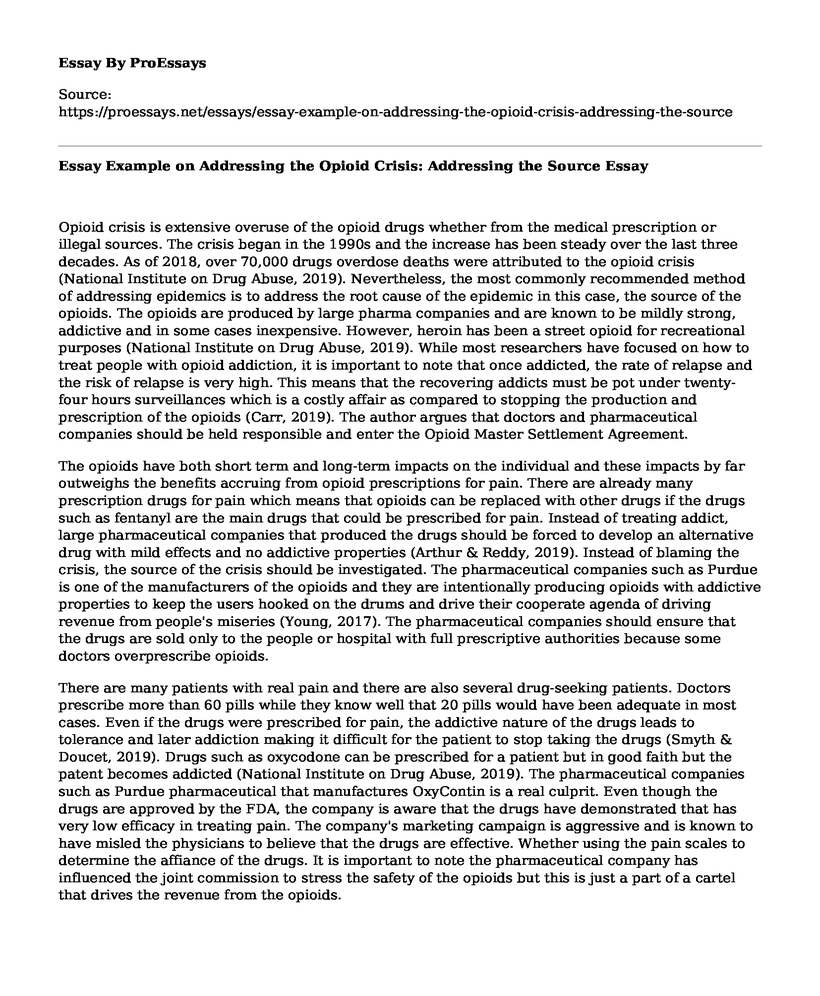Opioid crisis is extensive overuse of the opioid drugs whether from the medical prescription or illegal sources. The crisis began in the 1990s and the increase has been steady over the last three decades. As of 2018, over 70,000 drugs overdose deaths were attributed to the opioid crisis (National Institute on Drug Abuse, 2019). Nevertheless, the most commonly recommended method of addressing epidemics is to address the root cause of the epidemic in this case, the source of the opioids. The opioids are produced by large pharma companies and are known to be mildly strong, addictive and in some cases inexpensive. However, heroin has been a street opioid for recreational purposes (National Institute on Drug Abuse, 2019). While most researchers have focused on how to treat people with opioid addiction, it is important to note that once addicted, the rate of relapse and the risk of relapse is very high. This means that the recovering addicts must be pot under twenty-four hours surveillances which is a costly affair as compared to stopping the production and prescription of the opioids (Carr, 2019). The author argues that doctors and pharmaceutical companies should be held responsible and enter the Opioid Master Settlement Agreement.
The opioids have both short term and long-term impacts on the individual and these impacts by far outweighs the benefits accruing from opioid prescriptions for pain. There are already many prescription drugs for pain which means that opioids can be replaced with other drugs if the drugs such as fentanyl are the main drugs that could be prescribed for pain. Instead of treating addict, large pharmaceutical companies that produced the drugs should be forced to develop an alternative drug with mild effects and no addictive properties (Arthur & Reddy, 2019). Instead of blaming the crisis, the source of the crisis should be investigated. The pharmaceutical companies such as Purdue is one of the manufacturers of the opioids and they are intentionally producing opioids with addictive properties to keep the users hooked on the drums and drive their cooperate agenda of driving revenue from people's miseries (Young, 2017). The pharmaceutical companies should ensure that the drugs are sold only to the people or hospital with full prescriptive authorities because some doctors overprescribe opioids.
There are many patients with real pain and there are also several drug-seeking patients. Doctors prescribe more than 60 pills while they know well that 20 pills would have been adequate in most cases. Even if the drugs were prescribed for pain, the addictive nature of the drugs leads to tolerance and later addiction making it difficult for the patient to stop taking the drugs (Smyth & Doucet, 2019). Drugs such as oxycodone can be prescribed for a patient but in good faith but the patent becomes addicted (National Institute on Drug Abuse, 2019). The pharmaceutical companies such as Purdue pharmaceutical that manufactures OxyContin is a real culprit. Even though the drugs are approved by the FDA, the company is aware that the drugs have demonstrated that has very low efficacy in treating pain. The company's marketing campaign is aggressive and is known to have misled the physicians to believe that the drugs are effective. Whether using the pain scales to determine the affiance of the drugs. It is important to note the pharmaceutical company has influenced the joint commission to stress the safety of the opioids but this is just a part of a cartel that drives the revenue from the opioids.
Conclusion
The pharmaceutical companies such as Purdue are glut for the opioids crisis in America. Even though they do not directly encourage physician and hospitals from increasing the prescription, their advertises of the opioids as safety invoices the patient's perception about the drug's safety. Their preemptive defense does not exonerate them from the deceptive advertisement positioning the opioids as the only safest and strongest pain reliever. Basing their marketing gimmicks on patient satisfaction is also deceptive because patient satisfaction does not correlate with high quality. Finally, Purdue pharma should adhere to the advisement limits and pay the state to cover the cost of the opioid-related crisis. Therefore, all stakeholders should enter the opioid master settlement agreement which will involve paying for treatment and prevention efforts for all opioid addicts.
References
Arthur, J., & Reddy, A. (2019). Opioid Prescribing in an Opioid Crisis: What Basic Skills Should an Oncologist Have Regarding Opioid Therapy? Current Treatment Options in Oncology, 20(5). Doi: 10.1007/s11864-019-0636-3
Carr, E. (2019). The Work of 'Crisis' in the 'Opioid Crisis'. Journal of Extreme Anthropology, 0(0). Doi: 10.5617/jea.6851
National Institute on Drug Abuse. (2019). Opioid Overdose Crisis. Retrieved 16 September 2019, from https://www.drugabuse.gov/drugs-abuse/opioids/opioid-overdose-crisis
Smyth, M., & Doucet, R. (2019). The opioid epidemic: How did we get here and where do we stand? DALHOUSIE MEDICAL JOURNAL, 45(2). Doi: 10.15273/dmj.vol45no2.8991
Young, K. (2017). US opioid epidemic: it is harder to get the painkillers I legitimately need. BMJ, 21(11), j784. Doi: 10.1136/bmj.j784
Cite this page
Essay Example on Addressing the Opioid Crisis: Addressing the Source. (2023, Feb 09). Retrieved from https://proessays.net/essays/essay-example-on-addressing-the-opioid-crisis-addressing-the-source
If you are the original author of this essay and no longer wish to have it published on the ProEssays website, please click below to request its removal:
- SCADA Protection Overlap Amongst the Corporate Groups and Governmental Agencies
- Prophylactic Mastectomy Versus Preventive Drugs for BRCA1 and BRAC2 Gene Mutation Carriers Investigative Report
- Essay on Theoretical Foundations of Nursing
- Essay Sample on Technologies in Healthcare
- Teenage Pregnancy: A Growing Concern in Mauritius - Essay Sample
- NAM Ad Hoc Committee: Enhancing Nation Through Nursing - Essay Sample
- Asthma Diagnosis: Genetically Inherited & Worsening in Spring Weather - Essay Sample







